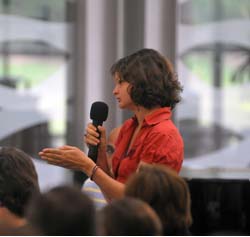
Science: Becoming the Messenger
 One hundred and seven researchers, faculty members and public information officers from across the state recently attended the NSF Science: Becoming the Messenger workshop in Norman to learn how to effectively communicate scientific research to individuals outside of academia. The event was sponsored by the National Science Foundation, Oklahoma Experimental Program to Stimulate Competitive Research (OK EPSCoR) and the National Weather Center.
One hundred and seven researchers, faculty members and public information officers from across the state recently attended the NSF Science: Becoming the Messenger workshop in Norman to learn how to effectively communicate scientific research to individuals outside of academia. The event was sponsored by the National Science Foundation, Oklahoma Experimental Program to Stimulate Competitive Research (OK EPSCoR) and the National Weather Center.
With funding agencies placing stronger emphasis on broader impacts criterion and researchers competing for a limited number of grant dollars, it is becoming increasing important for scientists to learn how to share the “man-on-the-street” relevance of their research with citizens and legislators.
Alan I. Leshner, executive publisher of Science magazine and CEO of AAAS, was quoted in a 2009 news release as saying, “Issues at the intersection of science and society—from human embryonic stem cell research to evolution, and from the study of “personal” topics such as sexual behaviors, to global climate change and vaccine development—may also drive some scientists to hone their presentation skills. At the same time, a weak economy may tend to prompt researchers and the lay public alike to become increasingly aware of the relationship between scientific capacity and national prosperity.”
“Everyone needs a fundamental understanding and comfort with science and technology in order to prosper in a modern society. It’s also true that communication between science and society must be positive and strong in order for science to thrive,” said Leshner.
NSF assembled an impressive team of communicators and trainers at the workshop to help members of the scientific community become more effective messengers, including Emmy award-winning television producer Joe Schreiber, bestselling science author Chris Mooney and NSF's Albert Einstein Distinguished Educator Fellow Buffy Cushman-Patz.
The 78 researchers and faculty members attending the conference learned how to craft a message and effectively deliver it to a variety of audiences. They also experienced live interview training, learned video production best practices, and developed public presentation and new media skills.
A special breakout session for the 29 public information officers in attendance was designed to build collaboration between PIOs and NSF Public Affairs.
Seventeen researchers were invited to attend a second day of training, where they learned to further refine their messages and honed skills that will enable them to talk more effectively to their colleagues, public audiences and the media. PBS television was on-site on day two of the workshop to interview Mooney and University of Tulsa mechanical engineering researcher Michael Keller for a future broadcast.
Dana Topousis, the National Science Foundation’s head of media and public affairs, has said, “The world is changing so much. We’re finding it ever-more important for researchers to be able to communicate with audiences that may not understand their research, and to be able to speak on their own behalf. Researchers themselves need to be able to communicate their work to generate broad public support for their goals.”
In addition, Topousis said, NSF works to inspire the next generation of scientists and engineers, and the best role models are today’s leading researchers.
The Norman workshop has provided Oklahoma researchers and PIOs with invaluable communication tools to help them more effectively meet the increasingly diverse communications needs of this century.
